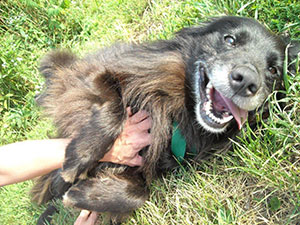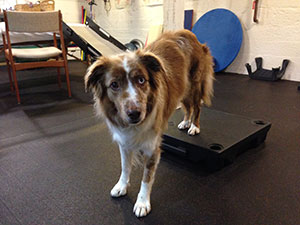A click for all ages
Originally published on 11/4/2014.
As your dog moves into her senior years you’ll probably notice some subtle changes—she groans a bit when changing positions, hesitates briefly when asked to sit, delays a bit on recall. Less subtly, she doesn’t follow you upstairs as often, quits jumping in agility, and pauses before making the jump into the car. Her body is aging, and her mind is likely not as agile as it was in her prime. Many of these effects of aging can be counteracted or lessened through training exercises that strengthen your dog’s body and mind. Get out the clicker for a couple of short training sessions at least every other day, and focus the training on new behaviors. It’s amazing what you and your dog can accomplish in less than 5 minutes a day.

Considering what might underlie changes in your dog can help to focus on the exercises that will be most effective. Your dog’s center of gravity is near her shoulders, so 65% or more of her weight is on her front end, which, therefore, receives more “strength training” than her rear. As she ages, her hind end will probably lose some of its power because the various muscles supporting it are atrophying and weakening. With muscle atrophy comes a loss of strength in tendons.
Your dog will also lose some of her capacity for proprioception and coordination. Proprioception is the sense of one’s own body position during movement, the knowledge of where a limb or other body part is in space and relative to the rest of the body. Exercises for the older dog often improve proprioception, as well as coordination, balance, strength, and mobility. Other benefits of exercises include being more functional in the home and various environments and increased interactions with family members.
Watching an older dog gain strength and physical and mental agility is very gratifying. Any training of new behaviors results in your dog working her brain to figure out what you are looking for; it's not too late to start teaching new behaviors that benefit both her aging mind and body. These exercises can empower you to keep your senior dog active, and to engage her in activities that make life better for both of you.
Start with the vet’s okay
Before beginning new training exercises for your aging dog, be sure to check with your veterinarian to make sure the exercises are safe for your dog. Have your veterinarian look for joint mobility, pain, and muscle atrophy.
Set goals

Training exercises will help keep your dog
feeling youthful and active
Goals for aging dogs can include reducing body weight, increasing joint mobility, and strengthening supporting muscles (which also reduces joint pain). Working toward those goals can result in the ability to climb stairs, an easier time getting in the car, and increased comfort with other activities, such as going for walks, that require better physical function.
Pay attention during training
Watch for subtle signs that your dog may not be comfortable with what you are asking her to do during training. Look for any possible soreness after the exercises as well, and stop if you notice any signs of pain or discomfort.
Make it fun by reinforcing with treats
Training sessions should be fun for both of you. Be ready to reinforce often. It’s often the case that picky eaters enjoy food more when they get to work for it—so don’t hold back! By all means, use some of your dog’s dinner if that works best for you. You can always have your dog lick a food tube containing something delicious, like a mashed stew or almond butter.
Seniors love platform work
I include platforms in my core set of training props for senior dogs. The platform is a wonderful tool for engaging and strengthening stabilization muscles, enhancing proprioception, improving balance, strengthening muscles, exercising your dog’s mind through training, and building confidence.
Platforms come in several sizes; you can even make one yourself in a size to suit you. Start with a platform about two to three inches high. You can start with a two- to three-inch coffee table book that you've wrapped with duct tape and to which you’ve added non-skid material. When it's time to move up in height, you can use something like the Blue-9 Klimb platform, 4.5" high with the legs stored. As for width, you’ll want a platform at least a few inches wider than your dog’s stance. If you are going to use your platform for other training that includes all four paws up, you’ll want the platform to be four to six inches longer than your dog while she is in a stand.
If your dog has balance issues, put her in a well-fitting harness, like the Balance Harness, that doesn’t restrict movement so that you can support her gently if needed. Be sure that the top of the platform is not slippery. You can add non-skid material to the top of the platform to ensure that it feels secure and safe for your dog.
The foundation exercise for platform work is a form of “perch work.” Put the platform on the floor only after you've made a plan, filled your treat pouch, and have your clicker ready (or are ready with your verbal marker--I often use “Yip!”).
Two Paws Up: Platform foundation exercise

Cassie with two paws
on the platform
The first behavior you work toward is stepping up to put two front paws on the platform (you will then build duration in this position). I usually shape this behavior. For detailed information on shaping, see this KPCT training article.
Begin by clicking any interaction with the platform and then delivering a treat, to increase the likelihood of repeating the behavior. Click interactions such as sniffing or starting to paw the platform, then treat. I usually position the delivery of the treat so that the dog moves forward onto or closer to the platform to get the treat. Note that it can also work to deliver the treat further away from the platform so your dog can move toward it again; trainer’s choice! I usually get a paw on the platform rather quickly, or at least a paw touch. If you are fast enough, you can click again as the front paw touches down on the platform and reinforce further forward for one or two paws on. Once you have two paws up, click and treat a few times, ending the behavior with a click and treat off of the platform. It should be much easier for your dog to step up now.
Remember to watch for fatigue and to give your dog plenty of breaks. You are looking for joy on your dog’s face and excitement when you bring out the platform. When you are ready for a break or to stop training, always pick up the platform to make it clear to your dog that this particular training session is over.
Once the behavior of stepping up with two paws on the platform is solid, you can build duration. I suggest that you initially build duration to about ten seconds per repetition up on the platform, and that you do three repetitions per set. After seven to ten days at ten seconds per repetition (sometimes 14 days, depending on the amount of atrophy in the hind end), you can then build to 30 seconds per repetition. Keep your dog at 30 seconds per repetition for at least seven to ten days before you increase the height (and at that same time lower duration again).
Note: This exercise will look easy, but you are intentionally starting off slowly so you can carefully observe if the dog is able to do even the first exercise without showing any indications of pain.
During each training session I suggest a set of three repetitions, spending at least a few seconds off of the platform between each repetition. Once the behavior is well established, you can add a cue. For more information about adding a cue, refer to this KPCT article.




Post new comment